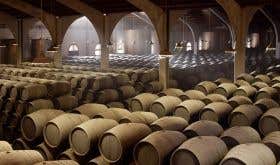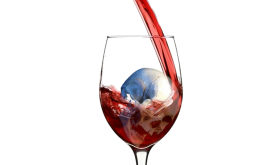When you consider the virtually infinite number of different foods and wines there are in the world, the probability of finding the ideal match seems vanishingly small. But human nature is nothing if not obstinate in the face of adverse odds. As witness Miles in Sideways, drinking Cheval Blanc 1961 with fast food.
Our own site has some rather more classy examples of food and wine matching. Tamlyn has provided several: most recently, a rosé blend from Toro with prawns and feta in a slow-cooked tomato sauce (Prawns and Páramos), and an off-dry 2005 Hungarian Furmint paired with home-smoked chicken (Furmint, a smoking hot food wine).
We can add another variable here: the probability of actually reproducing these exact matches. There’s a far greater chance of Tam making it for you chez elle, not least because she’s far too polite to turn anyone down. But that would be to miss the point. Tam’s eloquent descriptions provide the necessary sensory justification for why the matches work, but just as importantly convey the feelings evoked by these combinations: it’s as much mood matching as food matching.
Even so, descriptions will never substitute for personal experience, and there’s no guarantee that you will share someone else’s preferences. Instead, you can vicariously enjoy the descriptions of a combination and take inspiration from it.
All too often, however, food and wine pairing is taken far too literally, and the back label is a prime offender. Exhibit A: which wine is versatile enough to be a ‘flawless choice’ with light meats, grilled foods, seafood, pasta and young cheese? Oak-aged Pinot Noir from Texas, of course. That’s pretty versatile, but that’s nothing compared with those wines that are appropriate to go with your favorite food or meal (see labels below), whatever that might be – whether a sweet Riesling from Washington or a Californian Rhône blend.

But my favourite examples are the Italian white that goes with ‘black truffle receipts’ – you know, the slip of paper you got when buying them, upon which you can choke at the price – and the California Pinot Grigio that 'entwines' with a frankly bewildering array of choices from ham to guacamole to Asian takeout to tropical fruit. I’m always amused by vegan-friendly wines that are best paired with red meat too.

Back labels are often written by the marketing department (those Pinot Grigio matches sound like an office poll of what colleagues were having for lunch that day), so perhaps it’s unfair to scrutinise them so closely. Besides, there are some decent examples, which manage to be realistic and appealing – and which may evoke the all-important mood. Yellowtail do a pretty good job, which perhaps in part explains their phenomenal success.

Back label pairings are very much the domain of commercial wines, of course. You’re unlikely to find serving suggestions on the back of a Montrachet, although ham and guacamole would doubtless feature. In the absence of on-bottle advice, however, there is an entire industry devoted to the arcane art of food and wine matching.
Far be it from me to criticise, since I'm part of it. And after all, there is some age-old advice that has endured thanks to its reliability. Tannic reds such as Barolo with red meat, for example, and high-acid whites such as Chablis with oysters. But it doesn’t take long before you can find a whole host of increasingly surreal variations on these themes.
Chablis isn’t just a match for oysters: it also pairs with mushrooms, snails and street tacos – although only grand cru examples for the latter, it seems. Perhaps such adaptability is only to be expected for a style which is the classic blanc canvas. But outré matches for Barolo seem harder to stomach. Game, roast goose, grouse, steak and truffles is the conventional advice that our own site gives, but a quick delve into the world of the Guild of Sommeliers forum reveals that one successful pairing was ‘gelato and berries’ – a comment only made more wonderful by an apparently serious response below it asking ’any specific flavor on the gelato?’
It would be easy to scorn such an unconventional pairing, but in fact it serves as a reminder of the limitless subjectivity of wine. In context (‘My gf and I went to an Italian restaurant in Laguna Beach’), I don’t doubt that the Barolo and gelato was a great pairing. But if literally anything goes and there are no rules, then the floodgates are opened to all manner of abstruse and fanciful posturing on the subject.
In the end it comes back to the importance of matching wine with mood as much as food. Eating and drinking both reflects and celebrates our daily lives. From summer barbecues to candlelit dinners to more functional weekday meals, a glass of wine with your food is a daily ceremony that naturally promotes communion and conversation. When the mood is right, any combination can be enhanced – whether conventional or otherwise. That is the magic of wine.













